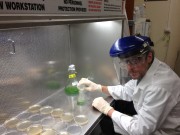Supervisors
Effect of pH on extrinsic proteins of photosystem II in Synechocystis sp. PCC 6803
Cyanobacteria are prokaryotic organisms capable of oxygenic photosynthesis, and the model species Synechocystis sp. PCC 6803 was the first photosynthetic organism to have its genome entirely sequenced. As a result, this organism is widely used in functional genomic and transcriptomic studies of the evolution and mechanism of photosynthesis.
In Synechocystis, a photosystem II (PSII) mutant ΔPsbO:ΔPsbU that lacks two extrinsic proteins known to stabilize the water-splitting oxygen-evolving complex showed supressed photoautotrophic growth low pH (pH 7.5) compared to high pH (pH 10); however, the mechanism of photosynthetic response to pH in Synechocystis remains unknown. A pseudorevertant of the ΔPsbO:ΔPsbU strain was found to be able to grow autotrophically at pH 7.5.
We have reconstructed the genomic sequences of the ΔPsbO:ΔPsbU and pseudorevertant strains, and are in the process of investigating candidate mutations that allow the pseudorevertant to grow at pH despite the lack of extrinsic PSII proteins. We hope to gain a greater understanding of the role of pH in cellular growth and photosynthesis.
Papers
CE Cornwall, PW Boyd, CM McGraw, CD Hepburn, C Pilditch, JN Morris; A Smith; CL Hurd (2014). Diffusion boundary layers ameliorate the negative effects of ocean acidification on the temperate coralline macroalga Arthrocardia corymbosa. PLoS ONE, in press.
JN Morris, TS Crawford, A Jeffs, PA Stockwell, JJ Eaton-Rye, TC Summerfield (2014). Whole genome re-sequencing of two 'wild-type' strains of the model cyanobacterium Synechocystis sp. PCC 6803. New Zealand Journal of Botany 52 (1), 36-47.
MY Roleda, JN Morris, CM McGraw, CL Hurd (2013). Ocean acidification and seaweed reproduction: increased CO2 ameliorates the negative effect of lowered pH on meiospore germination in the giant kelp Macrocystis pyrifera (Laminariales, Phaeophyceae). Global Change Biology 18 (3), 854-864.

